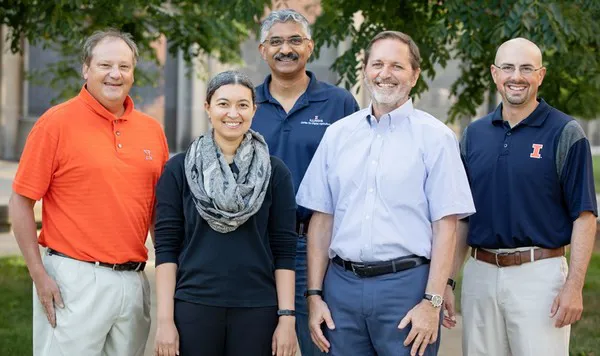The National Science Foundation (NSF) announced today an investment of $25 million to launch the Center for Research on Programmable Plant Systems (CROPPS). The center, a partnership among the University of Illinois at Urbana-Champaign, Cornell University, the Boyce Thompson Institute, and the University of Arizona, aims to develop tools to listen and talk to plants and their associated organisms.
“CROPPS will create systems where plants communicate their hidden biology to sensors, optimizing plant growth to the local environment. This Internet of Living Things (IoLT) will enable breakthrough discoveries, offer new educational opportunities, and open transformative opportunities for productive, sustainable, and profitable management of crops,” says Steve Moose, the grant’s principal investigator at Illinois. Moose is a genomics professor in the Department of Crop Sciences, part of the College of Agricultural, Consumer and Environmental Sciences (ACES).

As an example of what’s possible, CROPPS scientists could deploy armies of autonomous rovers to monitor and modify crop growth in real time. The researchers created leaf sensors to report on belowground processes in roots. This combination of machine and living sensors will enable completely new ways of decoding the language of plants, allowing researchers to teach plants how to better handle environmental challenges. “Right now, we’re working to program a circuit that responds to low-nitrogen stress, where the plant growth rate is ‘slowed down’ to give farmers more time to apply fertilizer during the window that is the most efficient at increasing yield,” Moose explains.
Futuristic
CROPPS research may sound futuristic, and that’s the point. The researchers say new tools are needed to make crops productive, flexible, and sustainable enough to feed our growing global population under a changing climate. Many of the tools under development – biotransducers small enough to fit between soil particles, dexterous and highly autonomous field robots, field-applied gene editing nanoparticles, IoLT clouds, and more – have been studied in the proof-of-concept phase, and are ready to be scaled up.
“One of the most exciting goals of CROPPS is to apply recent advances in sensing and data analytics to understand the rules of life, where plants have much to teach us. What we learn will bring a stronger biological dimension to the next phase of digital agriculture,” Moose says.
CROPPS will also foster innovations in STEM education through programs that involve students at all levels, and each partner institution will share courses in digital agriculture topics. CROPPS also aims to engage professionals in digital agriculture at any career stage, and learn how the public views innovations in this emerging technology area. “Along with research, CROPPS coordinated educational programs will address the future of work in plant sciences and agriculture,” says Germán Bollero, associate dean for research in the College of ACES.

For more information:
University of Illinois
www.illinois.edu
